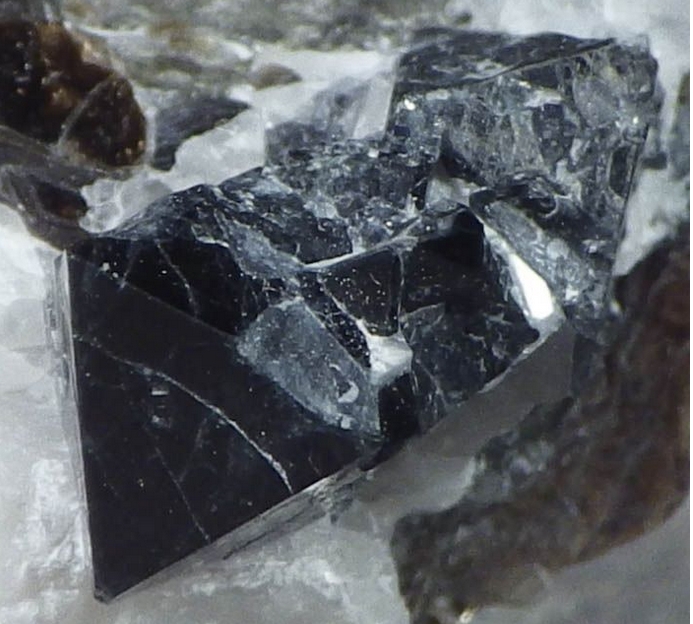Spinel Group Visible Spectra (generally 350 - 2500 nm)
The spinels are a diverse group of minerals with wide
variation in their chemical composition. Among the more common
spinel group minerals, the color is due to chromium and iron.
Rarely, cobalt will be a cause of color.
Natural MgAl2O4 Spinels
- Red
Cr-spinel, JQ-13, Sri Lanka. Visible Region only,
 plotted as 1.50 mm thick. The color comes from Cr3+.
data file
plotted as 1.50 mm thick. The color comes from Cr3+.
data file
- Blue
cobaltian spinel, Yakutia kimberlite pipe, Russia.
Approximately 0.05 mm thick. The color comes from Co2+
in the tetrahedral site. Contributed data from Michail N.
Taran, Kiev: data
file. Picture of
the crystal and the area of measurement.
- Blue cobaltian spinel, Samos
Island, Greece. Plotted normalized to 10.0 mm thickness. The color
comes from Co2+ in the tetrahedral site. Contributed
data from Michail N. Taran, Kiev: data file.
- Blue cobaltian
spinel, GRR 2381, Baffin Island, Nanavut, Canada. The blue color
 of the
crystals comes from Co2+ in the
tetrahedral site. 0.849 mm thick. data
file
of the
crystals comes from Co2+ in the
tetrahedral site. 0.849 mm thick. data
file - Blue cobaltian spinel, GRR 3017, from Viet Nam.
 . Plotted as 1.435 mm. Data file.
. Plotted as 1.435 mm. Data file. - Pale blue spinel GRR 2224, from Vietnam.
 Plotted at 2.986 mm. Data File
Plotted at 2.986 mm. Data File - Pale lavendar spinel. JQ-7,
 Plotted at 0.711 mm. Data file; Composition file.
Plotted at 0.711 mm. Data file; Composition file.
- RDS-153c
Pink spinel from Tanzania containing both Cr3+
and Fe2+. Here we see the near-infrared region
showing the absorption bands from Fe2+ in the
tetrahedral site. 0.503 mm thick; 1.028% FeO. Sample Sp3 of Shannon
& Rossman (1991) J Phys Chem Solids 52, 1055. data
file
Black Spinel Crystals
Gahnite, ZnAl2O4
- Green gahnite, GRR 2903, Pedras Bonitas Pegmatite, Rio Grande do Sul, Brazil.
 Plotted at 0.420 mm thick. Data File.
Plotted at 0.420 mm thick. Data File.
Synthetic Spinel-group materials
- MgAl2O4:Cr
spinel, synthesized by the flux method in Novosibirsk,
Russia. Normalized to 10.0 cm. Colored by Cr3+.
Data File: Contributed data from Anton Vasiliev, LAL, Moscow:
Spinel_Red,
25 K.
- MgAl2O4:Co
spinel, synthesized by the flux method in Novosibirsk,
Russia. Normalized to 10.0 cm. Colored by Co2+.
Data File: Contributed data from Anton Vasiliev, LAL, Moscow:
Spinel_blue,
25 K.
High pressure spinel polymorphs of olivine compositions
- γ-Ni2SiO4
Spinel, GRR 435 synthesized by Syuniti Akimoto.
- γ-Ni2SiO4
Spinel, published in Rossano et al. European Journal of
Mineralogy 1996:8, 471-475. Data file: Contributed data from
Stephanie Rossano, Paris: data file, 15 K.
 Back
to the list of minerals
Back
to the list of minerals
 Back
to the Index of Data Files
Back
to the Index of Data Files
 Back
to the
Mineral Spectroscopy home page
Back
to the
Mineral Spectroscopy home page
last
upgraded 9-July-2022
 plotted as 1.50 mm thick. The color comes from Cr3+.
data file
plotted as 1.50 mm thick. The color comes from Cr3+.
data file of the
crystals comes from Co2+ in the
tetrahedral site. 0.849 mm thick. data
file
of the
crystals comes from Co2+ in the
tetrahedral site. 0.849 mm thick. data
file . Plotted as 1.435 mm. Data file.
. Plotted as 1.435 mm. Data file. Plotted at 2.986 mm. Data File
Plotted at 2.986 mm. Data File Plotted at 0.711 mm. Data file; Composition file.
Plotted at 0.711 mm. Data file; Composition file.



